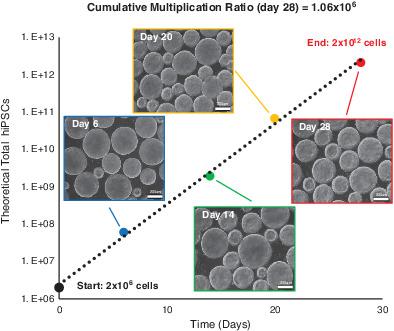当前位置:
X-MOL 学术
›
Stem Cells Transl. Med.
›
论文详情
Our official English website, www.x-mol.net, welcomes your feedback! (Note: you will need to create a separate account there.)
Optimized serial expansion of human induced pluripotent stem cells using low-density inoculation to generate clinically relevant quantities in vertical-wheel bioreactors.
STEM CELLS Translational Medicine ( IF 6 ) Pub Date : 2020-05-22 , DOI: 10.1002/sctm.19-0406 Breanna S Borys 1, 2, 3 , Tania So 1, 3 , James Colter 1, 2 , Tiffany Dang 1, 3 , Erin L Roberts 1 , Tamas Revay 4 , Leila Larijani 5 , Roman Krawetz 6 , Ian Lewis 7 , Bob Argiropoulos 4 , Derrick E Rancourt 5 , Sunghoon Jung 8 , Yas Hashimura 8 , Brian Lee 8 , Michael S Kallos 1, 2, 3
STEM CELLS Translational Medicine ( IF 6 ) Pub Date : 2020-05-22 , DOI: 10.1002/sctm.19-0406 Breanna S Borys 1, 2, 3 , Tania So 1, 3 , James Colter 1, 2 , Tiffany Dang 1, 3 , Erin L Roberts 1 , Tamas Revay 4 , Leila Larijani 5 , Roman Krawetz 6 , Ian Lewis 7 , Bob Argiropoulos 4 , Derrick E Rancourt 5 , Sunghoon Jung 8 , Yas Hashimura 8 , Brian Lee 8 , Michael S Kallos 1, 2, 3
Affiliation

|
Human induced pluripotent stem cells (hiPSCs) have generated a great deal of attention owing to their capacity for self‐renewal and differentiation into the three germ layers of the body. Their discovery has facilitated a new era in biomedicine for understanding human development, drug screening, disease modeling, and cell therapy while reducing ethical issues and risks of immune rejection associated with traditional embryonic stem cells. Bioreactor‐based processes have been the method of choice for the efficient expansion and differentiation of stem cells in controlled environments. Current protocols for the expansion of hiPSCs use horizontal impeller, paddle, or rocking wave mixing method bioreactors which require large static cell culture starting populations and achieve only moderate cell fold increases. This study focused on optimizing inoculation, agitation, oxygen, and nutrient availability for the culture of hiPSCs as aggregates in single‐use, low‐shear, vertical‐wheel bioreactors. Under optimized conditions, we achieved an expansion of more than 30‐fold in 6 days using a small starting population of cells and minimal media resources throughout. Importantly, we showed that that this optimized bioreactor expansion protocol could be replicated over four serial passages resulting in a cumulative cell expansion of 1.06E6‐fold in 28 days. Cells from the final day of the serial passage were of high quality, maintaining a normal karyotype, pluripotent marker staining, and the ability to form teratomas in vivo. These findings demonstrate that a vertical‐wheel bioreactor‐based bioprocess can provide optimal conditions for efficient, rapid generation of high‐quality hiPSCs to meet the demands for clinical manufacturing of therapeutic cell products.
中文翻译:

使用低密度接种优化人类诱导的多能干细胞的系列扩增,以在垂直轮生物反应器中产生临床上相关的量。
人类诱导的多能干细胞(hiPSC)由于具有自我更新和分化为人体三个胚层的能力而备受关注。他们的发现推动了生物医学的新纪元,以了解人类发展,药物筛选,疾病建模和细胞疗法,同时减少了伦理问题和传统胚胎干细胞相关的免疫排斥风险。基于生物反应器的过程已成为在受控环境中有效扩增和分化干细胞的一种选择方法。当前用于hiPSC扩增的方案使用水平叶轮,桨叶或摇摆波混合法生物反应器,这些反应器需要大量的静态细胞培养起始种群,并且仅实现中等程度的细胞倍增。这项研究的重点是优化hiPSCs的培养,一次性,低剪切,垂直轮生物反应器中的聚集体的接种,搅拌,氧气和养分利用率。在优化的条件下,我们使用少量起始细胞和最少的培养基资源,在6天内实现了超过30倍的扩增。重要的是,我们证明了这种优化的生物反应器扩展方案可以在四次连续传代中复制,从而在28天内累积细胞扩展为1.06E6倍。从连续传代的最后一天起的细胞是高质量的,可以保持正常的核型,多能标记染色以及在体内形成畸胎瘤的能力。这些发现表明,基于垂直轮生物反应器的生物工艺可以为高效,高效地提供最佳条件,
更新日期:2020-05-22
中文翻译:

使用低密度接种优化人类诱导的多能干细胞的系列扩增,以在垂直轮生物反应器中产生临床上相关的量。
人类诱导的多能干细胞(hiPSC)由于具有自我更新和分化为人体三个胚层的能力而备受关注。他们的发现推动了生物医学的新纪元,以了解人类发展,药物筛选,疾病建模和细胞疗法,同时减少了伦理问题和传统胚胎干细胞相关的免疫排斥风险。基于生物反应器的过程已成为在受控环境中有效扩增和分化干细胞的一种选择方法。当前用于hiPSC扩增的方案使用水平叶轮,桨叶或摇摆波混合法生物反应器,这些反应器需要大量的静态细胞培养起始种群,并且仅实现中等程度的细胞倍增。这项研究的重点是优化hiPSCs的培养,一次性,低剪切,垂直轮生物反应器中的聚集体的接种,搅拌,氧气和养分利用率。在优化的条件下,我们使用少量起始细胞和最少的培养基资源,在6天内实现了超过30倍的扩增。重要的是,我们证明了这种优化的生物反应器扩展方案可以在四次连续传代中复制,从而在28天内累积细胞扩展为1.06E6倍。从连续传代的最后一天起的细胞是高质量的,可以保持正常的核型,多能标记染色以及在体内形成畸胎瘤的能力。这些发现表明,基于垂直轮生物反应器的生物工艺可以为高效,高效地提供最佳条件,



























 京公网安备 11010802027423号
京公网安备 11010802027423号